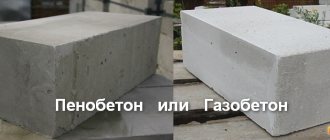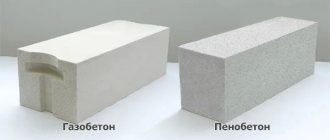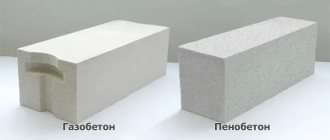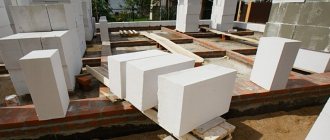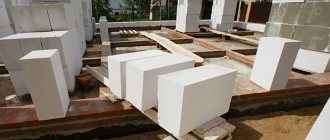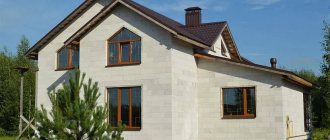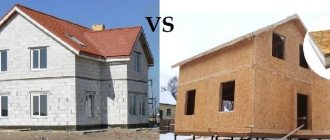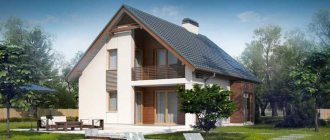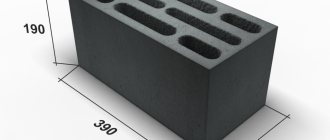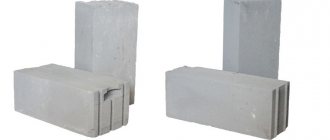Because of this, the construction time for buildings is reduced several times, and finishing work is easier and simpler, since there is no need to level the walls.
It appeared on the domestic market at the end of the 20th century: the variety of types of foam blocks will help you find out which particular cheese is useful for construction.
We will tell you in the article which foam blocks are best to build a house from.
Introduction
In the construction industry and private housing construction, various building materials are used to construct the walls of houses. Foam block is one of the most common building materials used in low-rise construction. Due to its relatively low cost, foam block is increasingly attracting the attention of potential home owners. But at the same time, people do not know what a foam block is. Which foam block to choose for building a house. In this article we will describe all the advantages and disadvantages of foam blocks.
Foam block is a building block made from foam concrete. Foam concrete is a type of cellular concrete. It is made from a solution consisting of cement, sand, water and a special foaming agent. Foam concrete is produced using cement binding material. Therefore, after production, foam concrete continues to gain strength for a long time. This should be taken seriously when purchasing a batch of foam blocks. Foam concrete and, accordingly, foam block have a porous structure due to numerous closed pores (air bubbles).
Advantages of foam blocks
Foam block has become widespread in the construction industry and in private housing construction due to its following advantages:
- the density of the foam block is sufficient for the construction of durable low-rise buildings;
- the thermal conductivity of the foam block is the lowest among other porous building materials;
- the frost resistance of the foam block allows it to be used in the construction of low-rise construction projects in northern latitudes;
- the moisture absorption of foam blocks is the lowest among the most common porous building materials;
- the durability of the foam block is quite sufficient to consider a house built from foam blocks as a permanent structure;
- ease of handling foam blocks during construction is due to their relatively low weight;
- the relatively high speed of construction of houses made of foam blocks due to its large dimensions;
- environmental friendliness of foam blocks produced using organic foaming materials;
- fire resistance of foam block;
- resistance of the foam block to biological effects;
- high soundproofing properties of the foam block due to its porous structure;
- lower cost of foam block compared to other building materials.
Disadvantages of foam block
In addition to the undoubted advantages described above, foam blocks have a number of disadvantages, namely:
- the fragility of foam blocks, which requires special attention when transporting the blocks and, directly, when erecting the walls of houses;
- shrinkage of foam blocks, requiring long-term storage of blocks in a warehouse after production.
There is also a main drawback of foam blocks, but we will talk about it at the end of this article.
Let's return to the topic of our article “Which foam block to choose for building a house.”
To decide which foam block to choose for building a house, you need to know well the features of the foam block. And also clearly understand the place of each foam block and its purpose in the structure of the house.
Progress
Now, after we have answered the main question posed in this article, let’s move on to a secondary one, namely: how to quickly build a house from foam blocks.
Of course, this is just a general diagram of how to build a house from foam blocks; in order to create a complete one, you need to know the nuances of a specific project.
And it looks like this:
Advice! Remove possible unevenness immediately with a plane.
Advice! It is recommended to reinforce the first and second rows, and then every 4-5 rows of masonry.
This instruction tells only in general terms how to build a house from foam blocks. For more detailed information, take a few minutes to watch the video in this article.
Technological characteristics of foam blocks, features in the structure and use in the construction of a house.
Foam block density
The structure of the house is a frame, which includes external and internal load-bearing walls, and internal non-load-bearing walls and partitions. Consequently, the walls of a house that are different in purpose have different requirements for the load-bearing capacity, thermal conductivity, frost resistance and other characteristics of the foam block. All of the above characteristics depend mainly on the density of the foam block.
Currently, the construction industry produces a wide range of foam blocks of various densities. Density refers to the load-bearing capacity of the foam block.
The density of the foam block is indicated by the letter D. The brand of the foam block, and, therefore, its density is determined by the numbers after the letter D. The construction industry produces foam blocks with a density from D 100 to D 1200.
According to their density, and therefore according to their use in the construction of a house, foam blocks are divided into:
- thermal insulation foam blocks;
- structural and thermal insulation foam blocks;
- structural foam blocks.
It is necessary to clearly understand the relationship between the density of the foam block and its thermal characteristics. The higher the density of the foam block, the higher its thermal conductivity and, therefore, the lower the thermal insulation properties of the foam block.
Consequently, a foam block is selected for building a house with a density and thermal conductivity that corresponds to its purpose in the structure of the house.
On the density of the foam blocks, i.e. The number of storeys of the house directly depends on their load-bearing capacity. In the field of low-rise housing construction, houses made of foam concrete above three floors are not built.
To build the walls of a particular residential building, it is necessary to select various foam blocks with an optimal ratio between the density of the foam blocks, their thermal characteristics, the scope of application in the construction of the house and its number of storeys.
Let's take a closer look at the classification of foam blocks by density and area of application in house construction.
Foam blocks with D 100, D 200, D 300, D 400, D 500 according to their thermal characteristics and classification belong to thermal insulating foam blocks.
Foam blocks with a density of D 100 and D 200 are practically not used in house construction. They are characterized by excellent thermal data, but practically zero load-bearing capacity.
If, due to too harsh climatic conditions, for example, in the far north, additional thermal protection of the house is required, then a second, internal non-load-bearing heat protection circuit of the house is erected. For the construction of such a heat-protective circuit, foam blocks with a density of D 400 or D 500 are used.
For the construction of external and internal load-bearing walls of a two-story house, it is necessary to choose foam blocks with a density of D 600, D 700, D 800, D 900 or D 1000.
Foam blocks with such a density belong to the category of structural and thermal insulating foam blocks.
They are characterized by sufficient load-bearing capacity and acceptable heat-shielding characteristics.
In accordance with the experience of building houses from foam blocks, experts recommend choosing foam blocks with a density of D 900 for the construction of external load-bearing walls of a two-story house.
The construction of internal partitions of a house has its own specifics.
For internal partitions, it does not matter what thermal properties the foam blocks from which they are built have. The strength of the partition and its load-bearing capacity are of great importance. The high load-bearing capacity of the partition allows you to hang various heavy objects on it, for example, kitchen cabinets.
In addition, strong partitions allow you to have heavy, durable, beautiful doors in the interior of your home. For the construction of durable internal partitions, foam blocks with a density of D 900 are required.
On the other hand, internal partitions must have high soundproofing qualities. For the construction of internal partitions with high sound insulation qualities, foam blocks with a density of D 300 are required.
To find a compromise between these opposing qualities of foam blocks, we suggest using foam blocks with D 600 in the construction of internal partitions.
Foam blocks with a density of D 1100 and D 1200 belong to the category of structural blocks. They have a high load-bearing capacity, sufficient for the construction of three-story houses.
We do not recommend building three-story houses from foam blocks. Therefore, we will not consider foam blocks with densities D 1100 and D 1200 in this article.
The strength characteristics of the foam block cannot be determined visually. Laboratory tests are required.
Thermal conductivity of foam block
A very important characteristic of a foam block is its thermal conductivity. The thermal conductivity of the foam block is directly related to its internal structure, i.e. structure. The thermal conductivity of the foam block is due to the presence of air-filled pores (air bubbles) in the structure of the foam block.
The fewer air bubbles in the structure of the foam block, the higher its thermal conductivity and load-bearing capacity. The more air bubbles in the structure of the foam block, the lower its thermal conductivity and load-bearing capacity.
For example, the presence in the structure of a heat-insulating foam block of grade D 300 of a huge number of large air bubbles makes it possible to reduce its thermal conductivity to the level of 0.08 W/m°C, which is an order of magnitude lower than that of concrete or brick.
Air is the most effective natural thermal insulation material.
The thermal conductivity of a foam block is directly dependent on its density. The higher the density of the foam block, the higher its thermal conductivity and, naturally, the lower the heat-shielding properties of the foam block.
The thermal conductivity characteristics of a foam block cannot be determined visually. Laboratory tests are required.
Thermal conductivity of foam blocks depending on their category and density.
Foam block dimensions
Currently, the construction industry produces foam blocks in the following sizes:
- 600 × 300 × 100 mm;
- 600 × 300 × 150 mm;
- 600 × 300 × 200 mm;
- 600 × 300 × 250 mm;
- 600 × 300 × 300 mm;
- 600 × 300 × 350 mm;
- 600 × 200 × 400 mm;
- 600 × 400 × 300 mm.
It is known that the larger the dimensions of the foam block, the higher its load-bearing capacity, the heavier it is. There is a natural direct relationship between the dimensions of the foam block and its cost.
Foam blocks with dimensions 600 × 300 × 100 mm and 600 × 300 × 150 mm are used in the construction of houses as internal non-load-bearing partitions.
In our opinion, partitions built from foam blocks of the above sizes do not belong to the category of long-term capital structures
For the construction of internal non-load-bearing partitions that have the necessary load-bearing capacity and sound insulation, foam blocks measuring 600 × 300 × 200 mm should be used.
For the construction of external and internal load-bearing walls of a house, it is necessary to choose foam blocks with dimensions of 600 × 300 × 300 mm, 600 × 300 × 350 mm, and best of all with dimensions of 600 × 200 × 400 mm. Foam blocks of the above sizes have high load-bearing capacity and the best thermal characteristics .
Foam block weight
The mass of foam blocks directly depends on its size, that is, dimensions.
Frost resistance of foam block
The frost resistance of foam blocks is indicated by the letter F. It shows the resistance of foam blocks to maintaining their structure during repeated freezing and thawing. Frost resistance is measured in cycles. The number of cycles is indicated after the letter F. This cycle allows you to select frost-resistant foam blocks for any climate zone.
For southern regions, the frost resistance of foam blocks should be in the range from F15 to F30.
For the central regions of Russia, it is better to choose foam blocks with a frost resistance rating in the range of F30-F50.
For the northern regions of Russia, the frost resistance of foam blocks should be in the range from F50 to F70.
For the far north of Russia, it is best to choose foam blocks with frost resistance above F75
The high frost resistance of F50-F100 is explained by the finely porous structure of the foam blocks, which provides a reserve volume for water migration when it freezes.
The frost resistance of foam blocks cannot be determined “by eye”. To determine the frost resistance of foam blocks, laboratory tests are required.
Which ones are better to choose?
with dimensions of 600x300x200 mm and a density in the range of 600-1000
are best suited .
The most popular option for building material today is foam block 600x300x200 mm with a density of D600.
If you plan to build a three-story house, then blocks with a density of 1100-1200 are suitable for this. The best material by type of manufacture will be the stone that was produced by the dry mineralization method.
In financial terms, it is better to choose a stone from a manufacturer : in Russia, prices on average range from 2,500 to 3,000 rubles per cubic meter. You cannot build walls from foam concrete with a density of 400-500: they are only suitable for creating thermal insulation.
Methods for determining the quality of foam blocks
There are several ways to determine the quality of foam blocks visually, as they say “by eye”. Thus, the following quality parameters of foam blocks can be assessed:
- the homogeneity of the structure of foam blocks must be uniform throughout the entire mass of the block;
- air bubbles in the structure of the foam block should be small (no more than 1 mm);
- the shape of the air bubbles should be spherical;
- the air bubbles should be approximately the same, not interconnected;
- The color of the foam block should be gray, the color of cement, uniform throughout the entire block. If the foam block is light gray in color, it means that the proportions between cement and sand in the solution are not met;
- The foam block should not contain cracks. The presence of cracks indicates the existence of tension inside the block, as a consequence of the improper drying process of the block;
- there should be no streaks on the foam block or uneven color of the blocks;
- the foam block should not have traces of grease from iron molds;
- high-quality foam blocks do not sink in water;
- good foam blocks do not wobble if they are placed on top of each other;
- a high-quality foam block cannot be broken by hand;
- high-quality foam blocks have the same geometric dimensions.
What you need to know and do before purchasing a batch of foam blocks
Before you begin choosing foam blocks for building a house, you must perform the following steps:
- study the requirements of GOST 21520-89 “Cellular concrete wall blocks, small. Technical conditions.”;
- find an organization that produces foam blocks in accordance with the requirements of this GOST;
- find out what documents confirming the quality of foam blocks are attached to each batch of manufactured blocks;
- see what technology is used to produce foam blocks at this enterprise (by injection molding into a multi-place iron mold or by cutting foam blocks from a common mass of foam concrete);
- find out if the company has its own testing laboratory;
- ask the opinion of the clients of this enterprise regarding the quality of the blocks.
All this is not at all difficult to do.
After reading this article and completing all the steps indicated in it, the reader will speak the same language with representatives of the foam block manufacturer.
Read on the same topic - “Making building interlocking blocks from foam concrete - video”
Read on the same topic - “Making tongue-and-groove wall slabs from foam concrete - video”
Content
Foam block is a porous building material made from a mixture of cement, water with sand and a foaming agent. This is one of the varieties of cellular concrete (foam concrete). But unlike aerated concrete, which is similar in structure, voids in it are formed not due to chemical reactions inside the block during the hardening process, but due to the mixing of the concrete mixture with pre-prepared foam.
The foaming agent used is organic or synthetic. The first protein-based option is more expensive, but the block with it is more durable and environmentally friendly. Synthetics are cheap, but have a 4th hazard class. The foam blocks themselves are safe, but you have to be more careful when mixing the solution when working with the original mixture.
Forms for pouring foam concrete mixture
This material for building houses is produced in two ways:
By cutting a monolith of hardened foam concrete into “bricks” of the required size;
Filling forms with the required dimensions in width, height and length.
The process of sawing an array of hardened foam concrete into blocks
To save on raw materials and increase the density of the blocks, ash, clay and other bulk fine-grained materials are often added to the mixture when mixing. On the one hand, this allows a significant reduction in cement consumption, and on the other hand, it leads to thickening of the interpore walls inside the foam block, making the product more durable. Moreover, the size of internal voids in this case decreases, increasing the thermal conductivity of the material.
Factors influencing the decline in the quality of foam blocks
As the construction industry and, especially, private housing construction developed, the demand for foam blocks increased sharply.
The low cost of equipment for technological lines for the production of foam blocks, the simple technology of producing foam blocks, and the high demand for foam blocks have created the prerequisites for the emergence of a huge number of organizations producing this building material.
Basically, these are responsible organizations that value their reputation.
But among them there are also organizations that work only during the construction season, according to the principle “the day feeds the year.”
Typically, such organizations operate in rented premises or, generally, in the open air. Such organizations usually do not have a warehouse for storing foam blocks until they reach the required strength. Foam blocks are made to specific order. When producing foam blocks, such organizations often violate the requirements of GOST 21520-89 “Cellular concrete wall blocks, small. Technical conditions."
Foam blocks produced by such organizations have a number of significant disadvantages, namely:
- due to the reduction in the aging (storage) period of building materials, foam blocks are subject to shrinkage;
- foam blocks have a heterogeneous structure due to insufficient mixing of the solution during the manufacture of foam blocks;
- foam blocks from the same batch are different in their geometric dimensions.
Foam block is a very serious building material. Foam block requires a very responsible attitude both at the manufacturing stage and during the construction of house walls from it.
Let's consider this issue in more detail. To do this, let's return to the table.
Thermal conductivity of foam blocks depending on their category and density.
Such thermal conductivity of foam blocks, or rather, the thermal conductivity of a wall built from foam blocks, is characteristic of foam blocks of exact and identical geometric dimensions. That is, all foam blocks used in the construction of the wall are absolutely identical to each other. This is very important when building walls of a house using foam blocks.
In this case, masonry of walls made of foam blocks is carried out using various assembly adhesives. The thickness of the seams between foam blocks is allowed within 1-3 mm. A wall built from foam blocks of equal size using mounting adhesives is homogeneous in relation to the environment.
If the foam blocks are of different geometric sizes, then the walls are laid using cement mortar. The thickness of the seams between foam blocks increases sharply.
The wall of a house, built from foam blocks of different sizes using cement mortar, is heterogeneous in relation to the environment. Consequently, the wall structure becomes heterogeneous in terms of thermal characteristics.
“Cold bridges” appear and the thermal efficiency of the wall structure decreases sharply. In addition, when the foam block is shaped like a large brick, the cement mortar seam is end-to-end for “cold bridges.”
In this way, the excellent thermal properties of foam blocks can be reduced to zero.
Construction of foam block houses - performing calculations
Before starting construction activities, it is important to correctly perform the calculations:
- determine the dimensions and layout of the building;
- calculate the need for material.
When determining the size of the house, consider the following points:
- land area;
- layout option;
- total expected costs.
Calculate the need for foam concrete blocks using the following algorithm:
- Determine the length of the foam block walls by summing up their dimensions.
- Calculate the area of the walls by multiplying the perimeter by the height.
- Subtract the area of the openings from the resulting value.
- Divide the result by the lateral surface area of the product.
Let's calculate the need for material for a building with dimensions of 6x8 m and a height of 2.8 m, which is planned to be built from blocks 59.8 cm long and 19.8 cm high:
- Let's calculate the area of the walls - (6+8+6+8)x2.8=78.4 m2.
- Let's determine the area of the door (0.8x2=1.6 m2) and window (1.4x1.6=2.24 m2).
- Let's sum up the area of the openings - 1.6 + 2.24 = 3.84 m2.
- Let's calculate the net area - 78.4-3.84 = 74.56 m2.
- Let's determine the area of the side surface of the blocks - 0.598x0.198= 0.118 m2.
- Let's calculate the need for material - 74.56:0.118=631.8.
We will definitely reinforce door and window openings.
Rounding the resulting value to a whole number, we get the need for building materials - 632 blocks. By comparing the amount of costs for purchasing block material for a house with dimensions of 6x8 m with the amount of brick for the construction of a building with the same dimensions, you can be convinced of the main advantage of the blocks - an affordable price.
